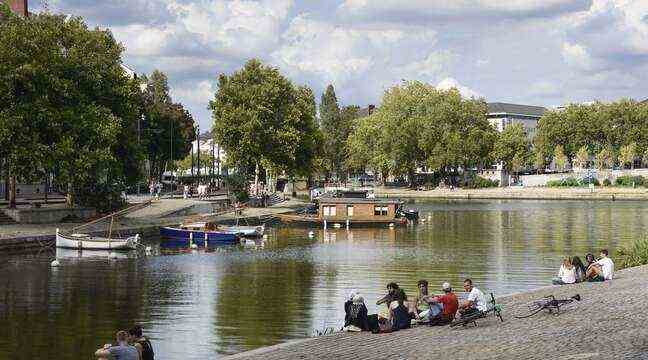View of the Erdre, in Nantes city center, in 2017 – S. Salom Gomis / SIPA
- Water not transparent enough, cohabitation with boats … Several obstacles exist for swimming in the Erdre.
- We must also add cyanobacteria, toxic when they proliferate.
In recent days, as every year when the temperatures go up in Nantes, young people do not hesitate to take a dip in the Erdre to cool off. On Sunday, a teenager even injured his shoulder while jumping from the Tortière bridge, which meant he was transported to the CHU. A dangerous practice (the draft of the Erdre is relatively low, about 1m60) while it is in any case forbidden to bathe in this river, for two main reasons.
“The first parameter is the transparency of the water,” explains Cédric Barguil, technician at theEdenn, the mixed union responsible for monitoring the quality of its water. In the Erdre, we have turbid water because of a very muddy bottom. The transparency, which should be around one meter for bathing water, is only around 30 cm here. Someone in danger in the water will disappear right away, unless you have a very supervised swim. If the police regulations which govern the Erdre prohibit swimming there, it is also because it is above all a waterway. In the city center, many boats of all sizes use it: it’s hard to imagine living with swimmers!
Rules also for practicing a nautical activity
However, there are many kayakers or paddle board fans who roam the river (and sometimes fall into the water). This is because nautical activities are subject to another regulation. However, “certain precautions must be observed when practicing leisure activities on waterways,” writes the departmental council, manager of Erdre. In the event of a fall in water, avoid ingesting water; take a neat shower after the nautical activity; consult a doctor in the event of the appearance of health problems … “
Because even spending a few minutes in the water, which can go up to 20 degrees in summer, is not without risk. And especially because of the many cyanobacteria, these tiny toxic algae that proliferate along “the most beautiful river in France”. “We monitor the episodes, during which they can produce various toxins: hepatotoxins, dermatotoxins, neurotoxins …”, details Cédric Barguil. Clearly, possible intestinal discomfort, skin irritation, even neurological disorders in the most serious cases.
Every week, a health check is therefore carried out. The results are available for consultation on the Edenn website, to find out if and where it is possible to practice your favorite nautical activity in complete safety.

